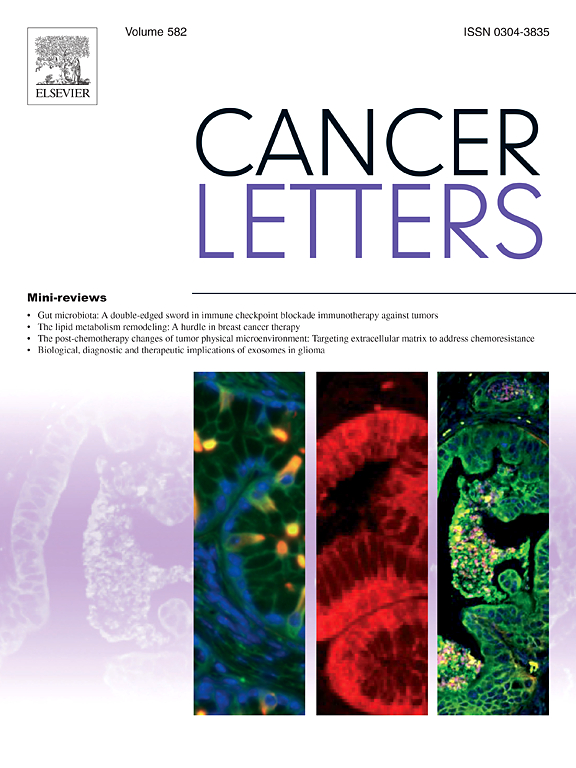Enhancing cancer radiotherapy efficacy using NanOx, a novel oxygenating perfluorocarbon nanoemulsion that reverses tumour hypoxia
IF 9.1
1区 医学
Q1 ONCOLOGY
引用次数: 0
Abstract
Radiotherapy is used to treat over 50 % of cancer patients. It is often used in combination with surgery, chemotherapy, and immunotherapy, for cancers of the breast, lung, oesophagus, and rectum. Ionising radiation predominantly exerts its anti-cancer effect through both direct DNA damage and indirectly via water radiolysis and the production of reactive oxygen species. This DNA damage is made permanent in the presence of molecular oxygen; however, it is reversible under hypoxia. Therefore, hypoxia confers significant radiotherapy resistance and given that it is a common feature of most solid tumours it offers a unique tumour vulnerability to exploit to improve radiotherapy efficacy. Many efforts to increase radiotherapy efficacy by oxygen delivery have failed due to limited efficacy and toxicity. To address this, we have developed a biocompatible, oxygenating perfluorocarbon nanoemulsion (nPFC) with imaging capacity via microCT with the view of delivering this intratumourally. We have demonstrated that this nPFC is biocompatible using an in vitro 3D liver hepatotoxicity model and in vivo using a developmental zebrafish embryo model. We have also shown that our nPFC can load and deliver a significant amount of molecular oxygen, reverse hypoxia, and enhance cellular radiosensitivity in an established in vitro isogenic model of acquired radioresistance in oesophageal adenocarcinoma (OAC) in accordance with the oxygen enhancement effect. Overall, this study demonstrates a potential method of enhancing cancer radiotherapy efficacy by locoregional oxygen delivery to hypoxic cells with acquired radioresistance.
使用NanOx增强癌症放疗疗效,这是一种新型的全氟碳纳米乳剂,可逆转肿瘤缺氧。
放疗用于治疗超过50%的癌症患者。它通常与手术、化疗和免疫疗法联合使用,用于乳腺癌、肺癌、食道癌和直肠癌。电离辐射的抗癌作用主要是通过直接损伤DNA和间接通过水的放射性分解和产生活性氧来实现的。这种DNA损伤在分子氧的存在下是永久性的;然而,在缺氧情况下是可逆的。因此,缺氧赋予显著的放疗抵抗,并且鉴于它是大多数实体肿瘤的共同特征,它提供了一个独特的肿瘤脆弱性来利用,以提高放疗疗效。许多通过氧气输送提高放疗疗效的努力由于疗效有限和毒性而失败。为了解决这个问题,我们开发了一种具有生物相容性、充氧性的全氟碳纳米乳(nPFC),该纳米乳具有通过微ct成像的能力,目的是在肿瘤内输送这种纳米乳。我们已经通过体外3D肝毒性模型和体内发育的斑马鱼胚胎模型证明了这种nPFC具有生物相容性。我们还在体外建立的食管腺癌(OAC)获得性放射抵抗的等基因模型中表明,我们的nPFC可以根据氧增强效应加载和传递大量的分子氧,逆转缺氧,并增强细胞放射敏感性。总的来说,这项研究证明了一种潜在的方法,通过局部氧输送到具有获得性放射抵抗的缺氧细胞来增强癌症放疗疗效。
本文章由计算机程序翻译,如有差异,请以英文原文为准。
求助全文
约1分钟内获得全文
求助全文
来源期刊

Cancer letters
医学-肿瘤学
CiteScore
17.70
自引率
2.10%
发文量
427
审稿时长
15 days
期刊介绍:
Cancer Letters is a reputable international journal that serves as a platform for significant and original contributions in cancer research. The journal welcomes both full-length articles and Mini Reviews in the wide-ranging field of basic and translational oncology. Furthermore, it frequently presents Special Issues that shed light on current and topical areas in cancer research.
Cancer Letters is highly interested in various fundamental aspects that can cater to a diverse readership. These areas include the molecular genetics and cell biology of cancer, radiation biology, molecular pathology, hormones and cancer, viral oncology, metastasis, and chemoprevention. The journal actively focuses on experimental therapeutics, particularly the advancement of targeted therapies for personalized cancer medicine, such as metronomic chemotherapy.
By publishing groundbreaking research and promoting advancements in cancer treatments, Cancer Letters aims to actively contribute to the fight against cancer and the improvement of patient outcomes.
 求助内容:
求助内容: 应助结果提醒方式:
应助结果提醒方式:


